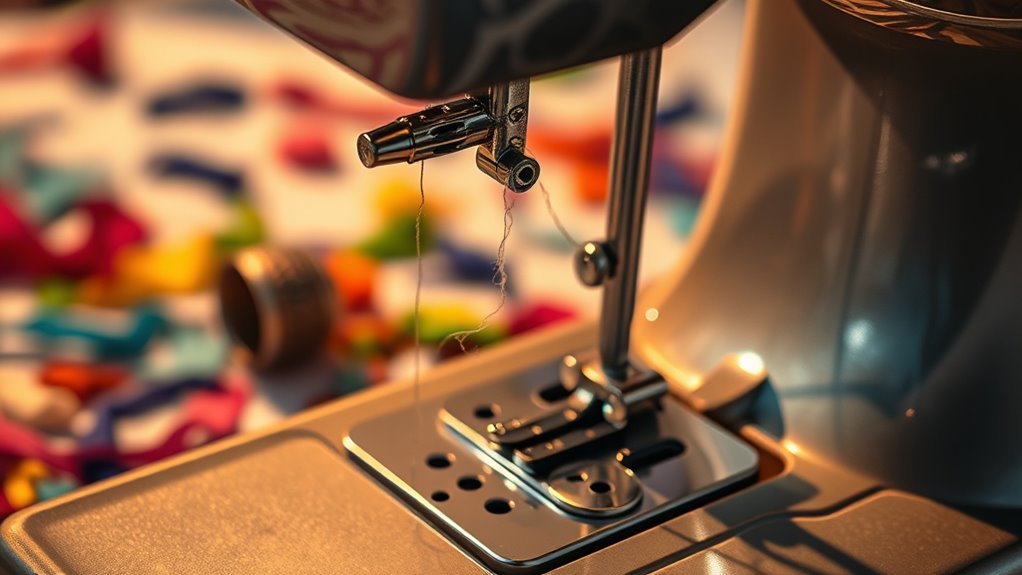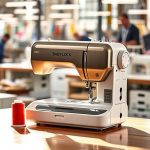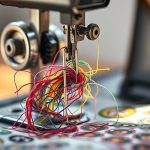Sewing machines can be dangerous if not handled properly. Needle injuries, electrical hazards, and risks from moving parts are common issues. It’s vital to understand machine mechanics and use safety features like automatic shut-off. Always wear safety goggles and use finger guards when sewing. Make certain you maintain your machine to prevent malfunctions. By following proper setup and handling techniques, you can minimize risks effectively. Discover further insights on how to sew safely and prevent accidents.
Understanding the Mechanics of Sewing Machines
The main mechanical operations involve the needle, feed dogs, and bobbin. Each component must function seamlessly to create consistent stitches.
For example, if the needle isn’t properly threaded or the bobbin isn’t inserted correctly, you could experience issues that affect your project’s quality.
Regular maintenance, like cleaning lint and oiling moving parts, guarantees smooth operation and longevity. Familiarizing yourself with the manual can also clarify specific functions.
Common Risks Associated With Sewing Machines
When using a sewing machine, you need to be aware of several common risks that can lead to injury. Needle injuries can occur if you’re not careful, while electrical hazards might arise from improper use or faulty wiring. Additionally, moving parts pose a significant risk, so always keep your fingers clear of the machine’s mechanisms.
Needle Injuries
While sewing can be a rewarding and creative endeavor, it’s important to recognize the potential for needle injuries that can occur during the process. These injuries often arise from improper handling of the needle, such as sewing too quickly or not keeping your fingers clear of the needle path.
To guarantee needle safety, always keep your hands at a safe distance from the needle while sewing. Regularly check for needle damage, and replace needles that show signs of wear. Additionally, using the appropriate needle type for your fabric can help prevent accidents.
Electrical Hazards
Needle injuries aren’t the only risks associated with sewing machines; electrical hazards pose significant dangers as well. To guarantee your safety while sewing, be mindful of the following:
- Damaged Cords: Frayed or exposed wires can lead to electrical shocks.
- Overloaded Circuits: Plugging multiple devices into one outlet increases fire risks.
- Moisture Exposure: Sewing near water can compromise electrical safety, risking electrocution.
- Ignoring Safety Regulations: Not adhering to safety regulations can expose you to preventable hazards.
Always keep your sewing space dry and organized. Regularly inspect your equipment for any signs of wear or damage, and follow electrical safety guidelines closely. Taking these precautions will help you sew safely and enjoyably.
Moving Parts Risks
Although sewing machines are incredible tools for creativity and craftsmanship, the moving parts present significant risks that can lead to serious injuries if proper precautions aren’t taken.
The needle moves rapidly and can cause puncture wounds if you’re not careful. It’s crucial to maintain a clear workspace to prevent accidents, like getting your fingers caught in the machine.
Always follow safety protocols, such as using the presser foot and needle guard. Additionally, keep your hair and loose clothing away from the moving parts to avoid entanglement.
Being aware of these risks enhances your safety while sewing.
The Importance of Proper Setup and Maintenance
When you neglect proper setup and maintenance of your sewing machine, you increase the risk of accidents and malfunctions that could lead to injury. Following a setup checklist and establishing a consistent maintenance routine is crucial for safe operation. Here are four critical steps to guarantee your machine stays in top shape:
- Check the needle: Verify it’s the right type and properly inserted to prevent breakage.
- Thread tension: Adjust it according to your fabric type to avoid jams and uneven stitches.
- Clean regularly: Remove lint and dust from the machine to prevent overheating and blockages.
- Oil as needed: Follow the manufacturer’s guidelines for lubrication to keep moving parts functioning smoothly.
Prioritize these steps to safeguard yourself while sewing.
Safety Features in Modern Sewing Machines
Modern sewing machines are equipped with a variety of safety features designed to protect users from potential hazards. Many machines include safety mechanisms like automatic needle shut-off, which prevents the needle from moving when the presser foot is raised.
This helps avoid accidental injuries. Additionally, some models have built-in sensors that detect if the fabric gets caught, stopping the machine immediately.
Always consult your user manual to familiarize yourself with these safety features and guarantee you’re operating your machine correctly. Ignoring safety protocols can lead to serious accidents.
Essential Safety Gear for Sewers
While sewing can be a rewarding hobby, it’s essential to prioritize safety by wearing necessary safety gear. Protecting yourself from potential hazards will help you enjoy your craft without worry. Here are four key items you should consider:
- Safety goggles – These protect your eyes from flying debris and accidental needle breaks.
- Finger guards – These prevent injuries from needle pricks, especially when working with delicate fabrics.
- Thimble – A thimble can shield your fingers from sharp needles while pushing through tough materials.
- Non-slip mats – These keep your machine stable and reduce the risk of accidents while you sew.
Best Practices for Using a Sewing Machine Safely
When using a sewing machine, it’s essential to guarantee proper setup to prevent accidents. Familiarize yourself with safe operation guidelines, as even minor lapses in attention can lead to serious injuries. Additionally, regular maintenance and care of your machine not only enhance its performance but also contribute to your safety while sewing.
Proper Setup Techniques
To guarantee your sewing machine operates safely, it’s crucial to set it up correctly before you start any project. Here are some best practices for proper setup:
- Sewing Space Organization: Keep your workspace tidy. Arrange tools, fabric, and thread within arm’s reach to minimize clutter.
- Machine Positioning Techniques: Place your sewing machine on a sturdy, flat surface, making sure it’s level to avoid unnecessary vibrations.
- Electrical Safety: Confirm the power cord is undamaged, and plug it into a grounded outlet to prevent electrical hazards.
- Lighting: Position your machine near adequate lighting to help you see clearly, reducing the risk of accidents.
Safe Operation Guidelines
Once your sewing machine is properly set up, understanding safe operation guidelines becomes essential to prevent injuries and guarantee a smooth sewing experience.
Make sure you’re familiar with sewing machine ergonomics; maintaining proper posture can reduce strain on your body. Always keep your hands away from the needle while sewing and never attempt to adjust settings while the machine is running.
Wear safety glasses if you’re working with heavy materials. It’s vital to undergo user safety training, as this will familiarize you with the machine’s specific features and safety mechanisms.
Finally, always unplug the machine when changing needles or attachments to eliminate the risk of accidental starts. Prioritizing these practices can greatly enhance your sewing safety.
Maintenance and Care
Although regular maintenance may seem like an added chore, it’s essential for ensuring your sewing machine operates safely and efficiently. Neglecting care can lead to accidents or malfunctions. Here are some best practices to keep in mind:
- Check thread tension: Improper tension can cause thread jams, leading to needle breakage. Always adjust according to your fabric type.
- Clean regularly: Dust and lint can accumulate, impacting performance. Use a soft brush to clean the machine’s interior.
- Lubricate the machine: Regular machine lubrication helps prevent wear and tear, ensuring smooth operation.
- Inspect the power cord: A frayed or damaged cord poses a significant risk; replace it immediately.
Handling Needles and Thread With Care
When working with sewing machines, it’s essential to handle needles and thread with care, as improper use can lead to serious injuries.
Always prioritize needle safety by ensuring the needle is securely attached and appropriate for your fabric type. Never try to remove a stuck needle while the machine’s running; always turn it off first.
For thread management, keep your workspace tidy to avoid tangles and reduce the risk of accidents. When changing thread, use scissors to cut any knots instead of yanking, which can lead to snapping needles.
Additionally, store spare needles in a safe container to prevent accidental pricks. By being vigilant about needle and thread handling, you can create a safer sewing environment for yourself.
Preventing Accidents While Sewing
To prevent accidents while sewing, it’s essential to guarantee your machine is set up properly and securely. Don’t underestimate the importance of using safety gear, like finger guards, to protect yourself from sharp needles and moving parts. Additionally, adopting mindful sewing practices, such as staying focused and keeping your workspace tidy, can greatly reduce the risk of injuries.
Proper Machine Setup
Setting up your sewing machine properly is essential for guaranteeing safety and preventing accidents while you work. Follow these steps to create a secure environment:
- Check machine alignment: Confirm your needle is positioned correctly and that the presser foot is securely in place. Misalignment can lead to machine jams or needle breaks.
- Adjust thread tension: Proper tension keeps the fabric from snagging or bunching, which can cause you to lose control.
- Secure your workspace: Keep your sewing area clean and free from clutter to avoid distractions or accidental entanglements.
- Use the right needle and thread: Choosing the appropriate needle for your fabric type helps prevent needle damage and guarantees smooth sewing.
Safety Gear Usage
Wearing the right safety gear while sewing can greatly reduce your risk of injury. Start with a pair of well-fitting safety goggles to protect your eyes from flying debris or needle breakage.
Use a thimble when hand-sewing to shield your fingers from sharp needles. If you’re working with heavy materials or sharp tools, consider wearing cut-resistant gloves as protective equipment.
Don’t forget to secure your hair and clothing, ensuring nothing gets caught in the machine. Finally, a sturdy pair of closed-toed shoes can help protect your feet from dropped tools or heavy fabric.
Mindful Sewing Practices
While sewing can be a wonderfully creative outlet, it is crucial to approach it with mindfulness to prevent accidents. Practicing mindful sewing not only enhances your focus but also serves as a great stress relief. Here are some key practices to keep in mind:
- Stay Focused: Avoid distractions. Turn off your phone or TV while you sew.
- Organize Your Workspace: Keep tools and materials tidy to prevent accidental slips or trips.
- Take Breaks: Step away periodically to clear your mind and reduce fatigue.
- Use Safety Features: Always engage the machine’s safety features and use proper foot placement.
Tips for Teaching Children to Sew Safely
Start by introducing sewing basics, like threading the machine and using scissors properly. Always guarantee child supervision, as even minor distractions can lead to accidents.
Set clear rules about keeping hands away from the needle and fabric while the machine is running. Encourage them to focus on their work, avoiding multitasking.
Use appropriate equipment, like safety scissors and machines with safety features, to minimize risks. Create a safe workspace, free from clutter, and teach them how to handle tools responsibly.
Finally, remind them to ask questions if they’re unsure about any steps, fostering an open and safe learning environment.
What to Do in Case of an Accident
Even with the best safety practices in place, accidents can still happen. If you find yourself in such a situation, it’s essential to act swiftly and effectively. Here’s what to do:
- Assess the Injury: Determine the severity of the injury and whether it requires immediate medical attention.
- Administer First Aid: For minor injuries, clean the wound, apply antiseptic, and bandage it securely. For serious injuries, avoid moving the person and keep them calm.
- Contact Emergency Services: If the injury is severe, call emergency contacts right away.
- Keep a First Aid Kit Handy: Always have a well-stocked first aid kit nearby while sewing, ensuring it’s easily accessible in case of an accident.
Being prepared can make all the difference.
Frequently Asked Questions
Can Sewing Machines Cause Long-Term Injuries to Users?
Yes, sewing machines can cause long-term injuries to users. Mechanical hazards and ergonomic risks, like repetitive strain and poor posture, can lead to chronic pain. It is crucial to practice proper techniques and take regular breaks to minimize these risks.
What Age Is Appropriate for Children to Start Sewing?
You can introduce children to sewing around age 7, but guarantee it’s in a structured environment, like sewing classes. Always provide close supervision to keep them safe while they learn and develop necessary skills.
Are There Specific Fabrics That Pose More Danger When Sewing?
Certain fabric types, like slippery silks or heavy denim, can be tricky. Just like a child learning to ride a bike, you need safety precautions—slow down, focus, and guarantee your workspace is secure to avoid accidents.
How Often Should I Service My Sewing Machine for Safety?
You should service your sewing machine every 6 to 12 months for peak performance. Regular machine maintenance and safety checks help prevent malfunctions, ensuring a safe sewing experience. Don’t neglect this essential upkeep for your equipment.
What Should I Do if My Machine Makes Unusual Noises?
If your machine’s making unusual noises, don’t ignore it. Like a car engine, it signals trouble. Start with noise troubleshooting and regular machine maintenance; check for loose parts or lint buildup to avoid bigger issues.


